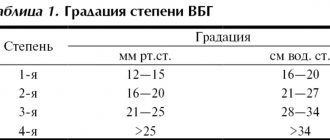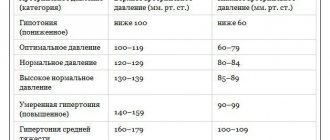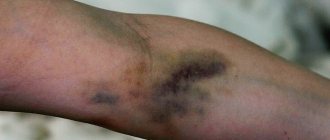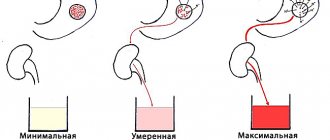Blood pressure is a kind of indicator. It shows the state of a person’s heart at the moment. It is not permissible to draw conclusions about health based only on the tonometer readings, but the readings of the device can give a signal if the heart begins to malfunction. And this means it’s time to contact a specialist. The device readings are encrypted into a special symbol system. Knowing what the numbers on a blood pressure monitor mean, you can prevent many serious conditions.
SYS and DIA numbers
Two numbers located one below the other indicate systolic and diastolic pressure. The first is measured during the ejection of blood or contraction of the heart muscle, and the second while it is relaxed. DIA (diastole) indicates the level of lower pressure, and SYS (systole) indicates the upper pressure.
Systole and diastole indicators on a tonometer
The normal rate is 135/85. Having seen such tonometer readings on the display, which mean the absence of hypertension and hypotension, you don’t have to worry about your health. For a more accurate result, it is better to take a measurement first on one hand and then on the other and calculate the arithmetic average of the two indicators.
Another significant factor is the difference between the upper and lower indicators. If the measurements show a difference much less or more than 50, then the user should report this fact to the attending physician.
A state of rest during diagnostics will help to avoid errors in the device readings. It is prohibited to speak or move until data appears on the device display.
The automatic tonometer responds to the following factors:
The sensitive sensor even reacts to air movement. You must behave calmly, not talk, keep your back straight. The tonometer cuff attached to the arm should be at the level of the heart. If you remove all interference and follow the instructions, the result will be correct. If you need to get a more accurate result, you can take measurements three times with the necessary break between them. After this, it is important to derive the arithmetic average. We must remember: the first indicator and the last may differ due to the artery getting used to compression or any involuntary movement, so triple measurements will provide more accurate data. We must remember that a decrease, as well as an increase in pressure beyond the normal range, is an alarm signal. It is necessary to find out the cause by contacting a cardiologist.
Very often, tonometers may not produce results at all or show incorrect results, as well as show different pressures for various technical reasons: they forgot to insert the batteries; the device is not used correctly; low-quality batteries that quickly fail. In order for electronic blood pressure monitors to work well, it is necessary to change the batteries on time. It is advisable to use only ALKALINE LR batteries for blood pressure monitors. They are more energy-intensive and guarantee a long service life, which is from 200 to 400 measurement cycles. Here, the word cycle means 2 – 3 times a day. Regardless of the manufacturer, LR batteries will ensure the operation of the tonometer for 4 – 6 months. When the tonometer is turned on, the display is tested, and if the device shows a symbol that indicates insufficient power, this means that the batteries are running low - it’s time to take care of new batteries. In addition to errors associated with measuring blood pressure with a device and technical reasons, different pressures can be completely physiological. It is worth remembering that active movements, stress, even sneezing and coughing increase blood pressure. This is a natural reaction and does not require medication. Blood pressure increases for a short time, and if you repeat the measurements a little later, the values will decrease significantly.
Heart rate
The third digit located on the device display is the pulse. This figure is located in the bottom row under the pressure indicators.
Heart rate indicator
It is not difficult to understand what this or that number located on various models of tonometers for measuring pressure means. Heart rate depends on the age and gender of a person; on average, this indicator varies from 60 to 90 beats in 60 seconds. A rarer pulse may indicate bradycardia, a more frequent pulse may indicate tachycardia.
Arrhythmia indicator
The arrhythmia indicator is an icon located on the device display. As a rule, it is located at the very bottom of the screen, closer to the center. Depending on the make and model of the device, the appearance of the icon can vary significantly, but most often this symbol looks like a flashing heart.
The icon lights up if the heart rhythm is uneven. This may indicate both the arrhythmia of the human heart and interference that arose during the measurement.
In order to exclude a random factor, you need to repeat the procedure after a few minutes. If, during three repetitions performed while the patient is at rest, an arrhythmia icon appears on the display, the user should report this fact to the therapist or cardiologist as soon as possible.
Graphic blood pressure level indicator
It can be difficult for an elderly person to keep a few numbers in mind and remember what normal blood pressure should be. For such people, as well as for greater clarity, many tonometer models have a graphic indicator of the blood pressure level.
Graphic blood pressure level indicator
All manufacturers position the scale differently. For some brands it is located on the body, while for others it is on the display. Figure 3 shows a tonometer with a scale placed on the body. A slider on the screen is displayed next to the danger level. The position of the slider in the green zone means that the indicator is within the normal range; if the slider is in the red zone, you should consult a therapist or cardiologist.
The letter e on the omron tonometer
Blood pressure is a kind of indicator. It shows the state of a person’s heart at the moment.
It is not permissible to draw conclusions about health based only on the tonometer readings, but the readings of the device can give a signal if the heart begins to malfunction. And this means it's time to contact a specialist.
The device readings are encrypted into a special symbol system. Knowing what the numbers on a blood pressure monitor mean, you can prevent many serious conditions.
High pressure indicator
Deviation of blood pressure readings from the norm is a serious signal that may indicate heart disease. And the treatment of such diseases must be approached without delay. That is why on the displays of some tonometer models there is an additional icon that signals high blood pressure.
Tonometer with high pressure indicator
Error symbols on the device screen
Device manufacturers have provided the ability to display errors in electronic tonometers on the screen. This allows the user to understand that the device is not working correctly, as well as find out the reason and take the necessary actions.
So, when measuring blood pressure with a Beurer BM 28 tonometer, errors may appear on the screen:
- E 1 indicates the impossibility of measuring pulse;
- E 2 indicates the impossibility of measuring pressure;
- E 3 appears when the cuff does not fit correctly - too loose or, conversely, too tight;
- E 4 indicates the occurrence of errors during the measurement process;
- E 5 is an error that appears when the inflation pressure is more than 300 mmHg;
- E 6 means a system error that requires contacting service.
Error symbols depend on the device model. Thus, on the screen of the Beurer BM 44 tonometer, the indication Er 1 will appear if it was not possible to measure systolic pressure, Er 1 - diastolic. If the readings are not within the intended measurement range, the Hi or Lo icons will appear. The device will indicate that the air has been inflated for too long or its excessive pressure, a malfunction of the system and incorrect position of the cuff. The designation of errors for each device is indicated in the instructions for it.
Motion indicator
On some tonometer models there is a motion indicator on the display. As a rule, it depicts a human figure.
Movements while using the device can cause the device to display incorrect data, which in turn will lead to an error in diagnosis. The appearance of a motion icon on the device screen encourages the user to assume a state of rest and take the measurement again.
Indicator of correct cuff fixation
Example of correct cuff attachment
To avoid this factor, the display of many tonometers includes an icon for correct cuff fixation.
Indicator of correct cuff fixation
For the manufacturer OMRON, this icon looks like the abbreviation OK enclosed in a circle. The presence of an active symbol indicates correct fixation of the cuff.
What do the numbers on the blood pressure monitor mean?
After measuring the pressure, numbers are displayed on the tonometer screen - indicators of pressure (upper/systological and lower/diastolic) and heart rate. All home blood pressure monitors have the same sequence of this data, regardless of the manufacturer.
Let us recall the norms of pressure and heart rate indicators with age correlation.
Heart rate - pulse
To obtain correct data, the pressure is measured three times on one arm with an interval of one minute. Some modern tonometers have the function of independently determining the average value calculated from three pressure measurements.
When measuring pressure, it is important to follow the rules:
- The wrist tonometer is worn at a distance of 1 finger from the hand.
- The Velcro strap is fixed so that there is no pinching of the hand.
- The cuff tonometer is attached to the arm at a distance of two fingers from the elbow bend so that the elastic tube passes through the center of the palmar surface of the hand;
- During the measurement, you must sit at a table - your hand should lie on a flat surface in a relaxed state, and the cuff should be at heart level.
- The cuff is secured with Velcro without squeezing or excessive loose space.
While measuring blood pressure, after pressing the button, it is forbidden to talk, move, move your arms, or clench your fists. Feet are on the floor; you cannot cross your legs.
The process of measuring pressure and its features on different types of devices
Most models have the same operating principle and are based on the Korotkov method, that is, pulse wave recognition.
The rules for working with a mechanical tonometer are as follows : first, place a cuff on the shoulder, then pump up air using a bulb and, slowly releasing it, listen to the first and last heart sounds using a stethoscope.
A semi-automatic tonometer is easier to use: having secured the cuff, just press the “start” button and after the signal, pump up the air with the bulb, and then deflate the remaining air in the cuff. The result will be displayed on the recorder screen.
The machine is the easiest to use. The person only needs to put the cuff in the correct place and press the button, after which the result will be displayed on the screen.
Designations on tonometers in the form of indicators on the screen
Different device models may have additional indicator icons that indicate health problems or measurement errors.
What does the arrhythmia indicator look like on a tonometer??
Some models of pressure measuring devices are equipped with an arrhythmia sensor. During the measurement process, the device notes the irregularity of the heartbeat; if the indicator appears frequently, you should consult a cardiologist.
In some cases, arrhythmia may interfere with the correctness of the measurement, then no data is displayed on the screen or an indicator with a heart appears (double or in quotation marks) - in this case, it is necessary to repeat the measurement.
- High blood pressure indicator in the tonometer
When the pressure rises above normal, an indicator appears on the monitor. In tonometers for home use, high blood pressure starts at 135/85.
- Pressure level scale
Next to the numbers indicating the current pressure there is a scale divided into three parts: the middle scale/yellow is normal, the lower/green is low pressure, the upper/red is high.
- Motion indicator on the tonometer
This icon appears if there were hand or body movements during the process. In some devices that do not have an indicator icon, the message “error/err” appears.
- The indicator on the tonometer flashes - crossed out battery
This is how the device indicates that it is time to replace the batteries.
When choosing measuring instruments for home use, it is best to give preference to trusted manufacturers. Many devices of unknown origin have serious disadvantages - inaccurate results and short service life. The Omron R2 tonometer has passed all the necessary quality tests and has the appropriate certificates. The compact measuring device will be a good helper for people who need constant monitoring of blood pressure and pulse both at home and while traveling.
Setting up a tonometer at home
There are several tips on how to test the mechanism for serviceability at home. There is a special installation that shows a certain pulse and breathing of a person, which it simulates. The tonometer is calibrated according to these data. But such an installation is very expensive and not everyone can afford it at home.
The second way is to connect two blood pressure monitors to one cuff, one of which will be precisely adjusted by a medical equipment specialist.
A reference tonometer can be set up at a pharmacy, after which you can calibrate your equipment using this data. An accurate device is necessary in the house, because its indicators can help to draw attention to the problem in time. It is necessary to check the equipment for malfunctions, and also always ensure that the pressure is measured correctly.
Why does the tonometer show different pressure? Users often ask about this when buying a new electronic device. It also happens that it shows different blood pressure (BP) if you measure it several times in a row. It turns out there are many reasons for this.
Why does the tonometer show the pressure incorrectly?
Tonometers are special medical devices that measure blood or eye pressure. In the latter case, the device is called a pneumotonometer. Such devices are an indispensable attribute of doctors. However, today blood pressure measuring devices are successfully used at home by many people, especially those suffering from hypertension and heart disease. A tonometer is even recommended for them, because patients must always keep their blood pressure under control in order to avoid complications caused by increased blood pressure. Tonometer readings are recorded as two measurements, for example, 120/80 mm Hg. Art. What do these numbers mean? This is the different pressure created in each of the two phases of the heart. The first reading is the highest blood pressure pumped by the heart. In our example, it is 120 - it is called systolic. The second reading is minimal. It is observed in diastole, when the heart relaxes, fills with blood, and then pushes it out. This “lower” pressure is referred to as diastolic.
Characteristics and components of Omron R2
The fully automatic device has a modern design, compact dimensions and a set of many useful functions. The tonometer is designed to measure pulse and blood pressure.
The compact and lightweight Ormon r2 tonometer will accurately measure pressure anywhere
The cuff is anatomical, made using a unique technology. Suitable for wrists with a circumference from 13.5 to 21.5 cm. Manufacturer's warranty - 60 months. The full technical characteristics and equipment of the tonometer can be found in the table:
Error correction
Errors may occur when using the tonometer. Some of them you can fix yourself. If this does not work for some reason, disassembling the device yourself is highly not recommended.
No one is safe from mistakes, not even a tonometer
Firstly, without knowledge of the features of this device, you can only aggravate the situation. Secondly, after opening the tonometer and damaging the factory seals, the free warranty period of service is automatically canceled.
The table shows the most common errors and methods for eliminating them.
| Type of error | Causes | Correction Methods |
| Flashing heart sign | Heart rate too high | Remove the device from your wrist, wait 10-15 minutes, and then measure your blood pressure again. If the situation repeats, then most likely the indicators are correct. In this case, you need to consult a doctor. |
| E E Snowflake symbol | The cuff is full of air | You need to remove the device from your hand, turn it off, and then turn it on. Next, you should measure your blood pressure again. |
| E 78 Snowflake symbol | The cuff is not securely fastened or there was movement of the arm during measurement | Turn off the device, turn it on, measure blood pressure again. |
| Er 25 | The symbol “E” with any code indicates some kind of malfunction in the device. | You need to contact the service center. |
| Indicators are too low or, conversely, excessively increased | This error can occur for several reasons: |
1. The cuff is not fastened correctly.
2. The hand with the device is not at heart level.
3. There were movements or conversations during measurements.
4. The arm is overextended.
Top 5 most common malfunctions of tonometers
Hello everyone! I continue to summarize and post in a condensed form my experience in electronics repair.
I present my Top 10 most common malfunctions of tonometers, which was born as a result of accidental repairs of medical equipment and communication with other Masters.
I won’t say that I’m a great specialist in this area, but I came across some things and successfully fixed them. Let's start the rating. The locations of malfunctions of tonometers and blood pressure meters are sorted by the frequency of occurrence of the malfunction.
How to disassemble the ANDUB-403 automatic wrist blood pressure monitor
When turned on, this blood pressure meter shows zero.
Then the cuff is inflated, but it is interrupted and the Err Cuf error appears on the display.
We turn the AND UB-403 tonometer sideways and see a plug that needs to be removed by prying it off with a thin slotted screwdriver or an awl.
On the other side of the case, remove the same plug.
This is what these cuff mounting plugs look like.
After this, we remove the cuff of the AND UB-403 tonometer and see the connection points of the pipes from the compressor to the cuff - there are two of them.
In these places, desealing and air leakage may occur, so we carefully inspect and clean the rubber seals of the tonometer pipes and cuff.
Let's try to put everything back together in reverse order.
If the cuff error remains, you need to check the cuff itself for cracks. This is usually done visually.
The rubber cuff of the blood pressure monitor can be repaired by gluing a patch to the air leak. To learn how to patch and repair a cuff, see the video below using the example of a Microlife tonometer cuff.
Storage and care
If you do not adhere to the rules for storing and caring for the tonometer, then the device is unlikely to last long. The more carefully you follow all recommended measures, the longer the measuring device will last.
- Do not expose the tonometer to impacts, falls or direct sunlight for a long time.
- Do not immerse the device in water or give it to children.
- If the tonometer is not used for a long time, the batteries must be removed from it.
- To avoid damaging the monitor and cuff, store the device in a special case.
To keep the device safe, store it in the case that comes with the kit.
If the device or cuff is dirty, do not use alcohol-based products, solvents, alkaline liquids, etc. for cleaning. It is best to wipe the monitor and cuff with a soft cloth (or slightly damp).
When choosing measuring instruments for home use, it is best to give preference to trusted manufacturers. Many devices of unknown origin have serious disadvantages - inaccurate results and short service life. The Omron R2 tonometer has passed all the necessary quality tests and has the appropriate certificates. The compact measuring device will be a good helper for people who need constant monitoring of blood pressure and pulse both at home and while traveling.
Characteristics and components of Omron R2
The fully automatic device has a modern design, compact dimensions and a set of many useful functions. The tonometer is designed to measure pulse and blood pressure.
The compact and lightweight Ormon r2 tonometer will accurately measure pressure anywhere
The cuff is anatomical, made using a unique technology. Suitable for wrists with a circumference from 13.5 to 21.5 cm. Manufacturer's warranty - 60 months. The full technical characteristics and equipment of the tonometer can be found in the table:
| In this case, it is necessary to correctly attach the cuff to the wrist and measure the pressure again, guided by the rules for measuring pulse and blood pressure. | ||
| No pressure in the cuff | This can only happen due to air leaking from the cuff. | Contact the service center in your city. |
| The cuff deflates too quickly | Incorrect attachment of the cuff to the wrist. | Apply the cuff correctly and then measure again. |
| Specifications | |
| Model | Omron R2 |
| Type | Automatic (wrist) |
| Cuff | Anatomical (13.5—21.5 cm) |
| Arrhythmia indicator | Eat |
| Memory | Yes (for the last 30 measurements) |
| Measurement thresholds: BP/Pulse | 0—299 mm Hg. st/40—180 beats per minute |
| Method of measurement | Oscillometric |
| Inflating air into the cuff | In automatic mode |
| Permissible error: BP/Pulse | +/- 3 mmHg st/+/- 5% |
| Intelligent program | Powered by intelliSense |
| Nutrition | AAA alkaline batteries (2 pcs) |
| Network operation | Impossible |
| Battery life | Approximately 300 measurements |
| Dimensions of the device Size/Weight | 71 x 41 x 70/117 g |
Why does the letter e appear on the tonometer?
Hello everyone! I continue to summarize and post in a condensed form my experience in electronics repair.
I present my Top 10 most common malfunctions of tonometers, which was born as a result of accidental repairs of medical equipment and communication with other Masters.
I won’t say that I’m a great specialist in this area, but I came across some things and successfully fixed them. Let's start the rating. The locations of malfunctions of tonometers and blood pressure meters are sorted by the frequency of occurrence of the malfunction.
1st place – loss of tightness of the tonometer cuff
If there is a loss of tightness in the pressure circuit in your tonometer, then with a high probability the “Err Cuf” error will appear on the screen of the automatic tonometer. Translated from English, cuff means cuff, so it is logical that the Err Cuf error is an error in the tightness of the cuff.
If your tonometer gives such an error, then first of all you need to check the connections between the cuff and the compressor. To do this, you need to remove the cuff. Let's look at how to do this using the AND UB-403 wrist tonometer as an example.
How to disassemble the automatic wrist blood pressure monitorANDUB-403
When turned on, this blood pressure meter shows zero.
Then the cuff is inflated, but it is interrupted and the Err Cuf error appears on the display.
We turn the AND UB-403 tonometer sideways and see a plug that needs to be removed by prying it off with a thin slotted screwdriver or an awl.
On the other side of the case, remove the same plug.
This is what these cuff mounting plugs look like.
After this, we remove the cuff of the AND UB-403 tonometer and see the connection points of the pipes from the compressor to the cuff - there are two of them.
In these places, desealing and air leakage may occur, so we carefully inspect and clean the rubber seals of the tonometer pipes and cuff.
Let's try to put everything back together in reverse order.
If the cuff error remains, you need to check the cuff itself for cracks. This is usually done visually.
The rubber cuff of the blood pressure monitor can be repaired by gluing a patch to the air leak. To learn how to patch and repair a cuff, see the video below using the example of a Microlife tonometer cuff.
How to seal a tonometer pad
It happens that the air supply becomes unsealed inside the device. In this case, you will have to disassemble the tonometer and eliminate microcracks or change dried rubber bands.
If you do not understand how to disassemble the tonometer, then I advise you to watch the following video on how to properly disassemble AND UB 201 .
2nd place – segments of numbers on the tonometer display disappear
Another part of the disease is the detachment of the cable of the LCD screens of tonometers, as a result of which segments of numbers and letters may not be displayed on the display.
To repair such a malfunction, you will have to disassemble the blood pressure meter again and repair the cable contacts. I analyzed cases of cable detachment and repair of such cases for TVs and monitors in an earlier article.
The tonometer display cables are glued using the same principle. Repair is made easier due to the nice size and pitch of the cable contacts. Repairing such cables is much easier than in TVs.
After disassembling the tonometer, you can glue the display cable back by uniform heating using a hot air gun or a soldering iron with a special attachment for repairing cables. Watch the video on this topic - very informative and interesting.
3rd place – the tonometer buttons do not work
In automatic and semi-automatic tonometers, operation is controlled using tact buttons. These buttons do not last forever and eventually fail - they do not press, they dangle, they press without a click, they press with a click, but without any result.
If the tonometer button is faulty, you have to disassemble the device, disconnect the electronic board, unsolder the old one and solder in a new button. In principle, nothing complicated, you just need to choose exactly the same button, because there are a great variety of seats, shapes and sizes of buttons.
For an example of common buttons, see the video on disassembling and replacing a tonometer button.
4th place – the tonometer does not measure blood pressure correctly
Before talking about the fact that the tonometer does not measure pressure correctly, it is necessary to determine the measurement errors and the factors that increase them.
Everyone knows that the vast majority of modern blood pressure meters work using the N.S. tone method.
Korotkov, which was even recognized as officially recommended by the World Health Organization.
This indirect measurement method has some error, determined by the elasticity of the walls of the arteries and soft tissues, the amplitude and shape of the pulse wave, and other factors that are different for each person.
If we abandon rounding and accurately use the division value of the pressure gauge, we will see the difference between adjacent measurements and when using a mechanical tonometer. Numerous experiments have shown that the error of N. S. Korotkov’s tone method is usually within the range of ±5-7 mm Hg. Art.
The error of manual tonometers consists of three components: the error of the method, the accuracy of the pressure gauge and errors in determining the moment of reading the readings. It turns out that the error in measuring blood pressure can reach up to 15 mm Hg. Art . This must be taken into account before taking medications to normalize blood pressure.
To be confident in the tonometer readings, metrologists and doctors advise taking several measurements with a break between them of at least 3-5 minutes. In approximately this time, the cross-sectional diameter of the vessels is restored, which helps to increase the accuracy of measurements.
From an electronics point of view, of course, there may also be reasons for an increase in measurement error. The pressure sensor and microcontroller are responsible for this. Less commonly, there may be problems with the firmware and supply voltage.
5th place – malfunction of the tonometer electronics
Before repairing the tonometer, you must carefully inspect the printed circuit board for microcracks and poor soldering. Solder suspicious areas, and check suspicious radio elements or replace them with similar ones.
Source: https://planshet-info.ru/kompjutery/pochemu-na-tonometre-vysvechivaetsja-bukva-e
Error correction
Errors may occur when using the tonometer. Some of them you can fix yourself. If this does not work for some reason, disassembling the device yourself is highly not recommended.
No one is safe from mistakes, not even a tonometer
Firstly, without knowledge of the features of this device, you can only aggravate the situation. Secondly, after opening the tonometer and damaging the factory seals, the free warranty period of service is automatically canceled.
The table shows the most common errors and methods for eliminating them.
| Type of error | Causes | Correction Methods |
| Flashing heart sign | Heart rate too high | Remove the device from your wrist, wait 10-15 minutes, and then measure your blood pressure again. If the situation repeats, then most likely the indicators are correct. In this case, you need to consult a doctor. |
| E E Snowflake symbol | The cuff is full of air | You need to remove the device from your hand, turn it off, and then turn it on. Next, you should measure your blood pressure again. |
| E 78 Snowflake symbol | The cuff is not securely fastened or there was movement of the arm during measurement | Turn off the device, turn it on, measure blood pressure again. |
| Er 25 | The symbol “E” with any code indicates some kind of malfunction in the device. | You need to contact the service center. |
| Indicators are too low or, conversely, excessively increased | This error can occur for several reasons: |
1. The cuff is not fastened correctly.
2. The hand with the device is not at heart level.
3. There were movements or conversations during measurements.
4. The arm is overextended.
Correct pressure measurement
To measure blood pressure, you need to put a special cuff on your arm.
It should be 1-2 centimeters above the inner bend of the elbow. The cuff must fit the person in size. It shouldn’t put too much pressure on your hand, but it shouldn’t “hang” on it either. After this, the air is pumped with a special rubber bulb, independently or with outside help. After this, the pressure will be known.
Enter your pressure
Avoiding errors in readings when measuring pressure
Sometimes the tonometer can give incorrect data, so you should always monitor its accuracy. First of all, you need to know that there are several types of devices:
- Mechanical tonometer. It is more difficult for them to measure pressure - this should be done by a doctor or a person with very good vision and hearing, who can accurately recognize the pulse in the headphones and the desired indicator on the dial.
- Electronic or automatic blood pressure monitor. This is a modern device that everyone can use - you just need to use it correctly and it will display the pressure on the screen.
It is impossible to say which of these devices is more accurate. If used correctly, they will both show the correct indicator. But in both cases errors are possible. An electronic device will most likely malfunction if the battery charge is low. It is also impossible to obtain the correct result if the bulb, electronic unit or cuff is faulty. Calibration of the mechanical apparatus is also necessary. To avoid mistakes, before measuring blood pressure, you should refrain from drinking alcohol, coffee and strong tea, smoking, and physical activity. You cannot talk or take your pulse when you are nervous. To obtain accurate readings, it is better to measure your pulse in the morning and evening three times, with breaks of 5-10 minutes. The lowest number will be the most accurate.










